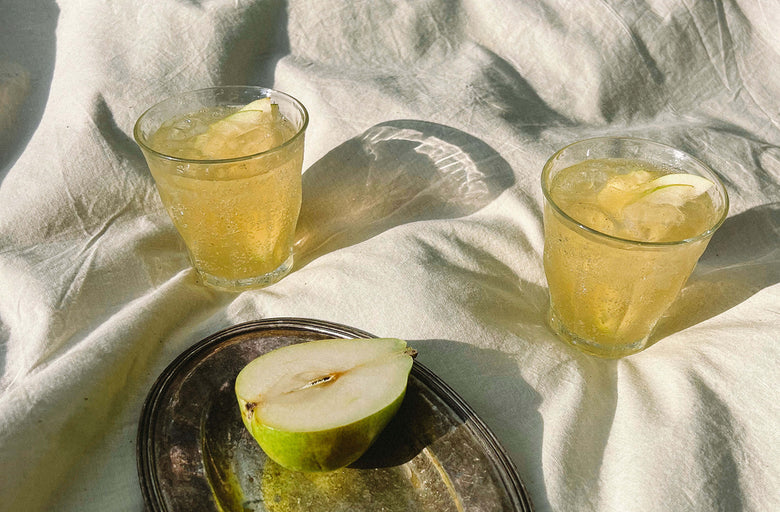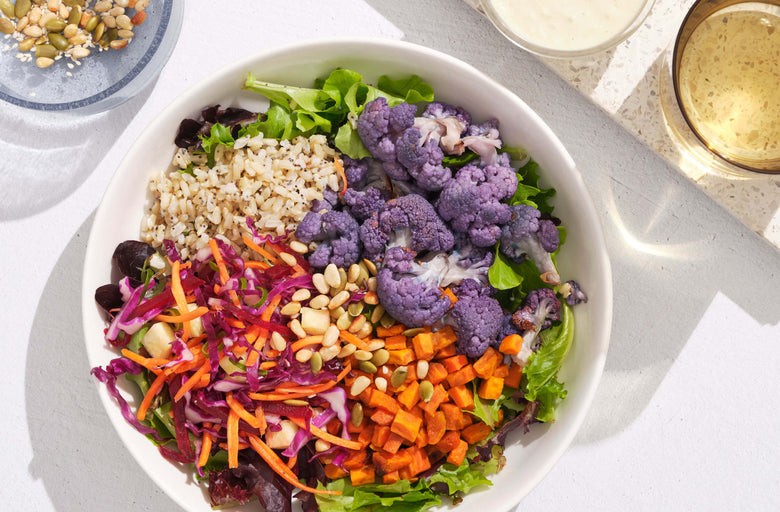For chef, food storyteller, and food stylist Camille Becerra, locality and seasonality rule the day-to-day. In spring, that means ramps and rhubarbs. Come summer, cherries and tomatoes. Watermelon in winter? Way out of the picture.
“You always want to eat what is growing at that moment around you… because your body is also in tune with the seasons,” says Becerra.
Her style of cooking today—healthful, colorful, seasonal, and, in her words, “simple”—is rooted in her early career. Post-culinary school, Becerra studied macrobiotic cuisine while working with Philadelphia-based cancer patients, followed by a stint at a New Mexico Zen monastery. She then went on to build her name (and share her talents) across a variety of female-owned and -led restaurants and kitchens, many of which were vegetarian, vegan, or macrobiotic.
Becerra’s accomplished career includes opening much-beloved (and missed) Brooklyn restaurant Paloma and working at a slew of downtown Manhattan gems—including seafood-focused Navy in Soho; a plant-forward residency at Café Henrie in the Lower East Side; and conceptualizing and opening James Beard Award-winning De Maria in Nolita. In addition, Becerra designed the full menu at Casa Pueblo in Tulum and has a forthcoming cookbook featuring some of her best-known dishes.
Recently, we tapped Becerra for an intimate seated dinner celebrating the launch of the Sakara Science Council—using the Sakara “Eat Clean, Play Dirty” cookbook as her culinary springboard. Plant-powered beauty ensued—including a bright sweet potato tartine, a velvety spinach-artichoke soup, and a lush carrot risotto.
(Becerra also made the Sakara Seed Bread—found exclusively in the Sakara cookbook—and took the leftovers home, cutting the slices really thin and transforming them into crackers. Chef’s kiss.)
Below, Becerra shares her insights on all things nourishment, cooking with her senses, and what she’s craving this spring.
On Her Food Philosophy: “Local. Seasonal. I like to take advantage of superfoods, but without banging people over the head by saying, Hey, this is healthy. I like to make food interesting—developing pairings in terms of different ingredients that grow together—and keep it simple.”
On Her Hunger: “My hunger applies to not only food hunger, but also to my hunger to feel good. Food is such a big part of how I feel. I'm always very much inspired to continue my research on different foods, and how people ate before the industrialization of food. There's so much to know; there's so many cultures that have these beautiful techniques and traditions. I'm very inspired by that, especially when I travel. The ultimate yearn is just eating well as a lifestyle, and all that comes with that.”
On “Eating Well”: “I define it based on locality, based on seasonality, based on really cared-for ingredients. (I think that should not be a luxury, but very much is still.) Then, how it affects my body—understanding and listening to my body, what it needs, and what it's craving.”
On Body Intelligence: “I think there’s an act of building a conversation with your body, understanding, Oh, I'm craving this. Well, maybe you're craving that because your body is lacking that nutritional aspect of that thing. Also, I think that when we go to the market, we visually connect with something, and that's another aspect of how your body is talking to you. That's really important to just build conversation with your body and understand what you need, not being so restrictive.”
On Boundaries: “My indulgence is just not limiting myself. I already put limits on what and where I'm getting my food. Like, I'm limiting myself by not having tomatoes until July, August, September. I already [honor] these limitations, so I just try and eat what I want.”
On the Spring Awakening: “The real luxury is when things are grown outside. I think spring greens, spring onions, and rhubarb are always really wonderful [in spring]. And I love flowers, like lilacs. I can't wait for lilacs to come in.”
On the Orchestra of the Kitchen: “I cook with all of my senses. Like, I want to hear how that boil is: Is it too hard? Is it too low? Has it been there for a while and I still don't hear any action? I want to hear what the food is saying. I don't like listening to music [while cooking] because it'd be like people that ride a bicycle with headphones on. That, to me, is so scary.”
On Superfood Must Haves: “Turmeric is super versatile. I incorporate it into my cooking whenever I can, as well as add a little bit of turmeric liquid extract to my morning acidulated water. It helps with internal and external inflammation. Also, cranberries are a Mid-Atlantic superberry. I feel like we've kind of gotten used to using others from outside this region, so I'm always trying to bring up the cranberry.”
On Sakara Essentials: “I love the chocolate granola. That's a huge hit here [at my place]. My daughter also loves the drops, the Detox Water Drops.”
On What Else She’s Cooking: “My upcoming cookbook is basically my career's work. It's like 175 recipes; it’s all the recipes that I've ever developed that are hits within my food and restaurant career, aimed at the home cook.”
(Becerra’s cookbook, Bright Cooking, is set to launch Spring 2023.)
MORE WAYS TO EMBRACE THE SEASON
6 Seasonal Ingredients to Stock Up On
Springtime Pasta with Fennel and Leeks
Your Allergy Cure-All
Crispy Spring Flatbread with Sunflower Seed Crema






